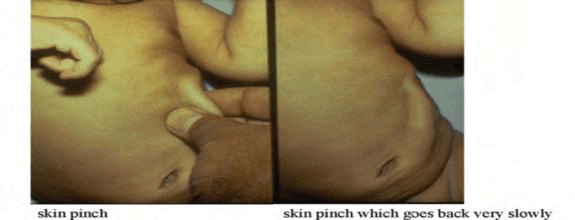Assessment of diarrhoea
Step 1: Ask the mother for diarrhoea for her child
- Does the child have diarrhoea?. All sick children that come to your health post, their mother should be asked for diarrhoea.
- If the mother answers no, ask about the next main symptom, fever. You do not need to assess the child further for signs related to diarrhoea.
- If the mother answers yes, or if the mother said earlier that diarrhoea was the reason for coming to the health post, record her answer as diarrhoea.
- You will now look at the steps for assessing diarrhoea in a child in detail.
Step 2: Ask the mother to assess persistency: How long has the child had diarrhoea?
- Give the mother time to answer the question. She may need time to recall the exact number of days.
Step 3: Ask the mother to assess dysentery: is there blood in the stool?
- Ask the mother if she has seen blood in the stools at any time during this episode of diarrhoea.
Step 4: Check signs of dehydration.
i) Look at the child's general condition, and if he/she is restless and irritable. If a child who becomes dehydrated, he or she will restless and irritable at first. The restless and irritable child is restless and irritable all the time or every time he is touched and handled. If an infant or child is calm when breastfeeding, but again becomes restless and irritable when breastfeeding stops, he has the sign "restless and irritable". However, many children are upset just because they are in the health post and unfamiliar surroundings. Usually, these children can be consoled and calmed. They do not have the sign "restless and irritable".
ii) Look at the child's general condition lethargic or unconscious
If dehydration continues without treatment, the child becomes lethargic or unconscious. The child becomes weak and goes to sleep or may not react to you and the mother. When you checked for general danger signs, you checked to see if the child was lethargic or unconscious. If the child is lethargic or unconscious, he has a general danger sign. Remember to use this general danger sign when you classify and record the child's diarrhoea.
iii) Look at the child's general condition sunken eyes
As the child's body loses fluids, the eyes may look sunken (Figure 5.1, below). The eyes of a child who is dehydrated may look sunken. Decide if you think the eyes are sunken. Then ask the mother if she thinks her child's eyes look unusual. Her opinion helps you confirm whether the child's eyes are sunken or not.
The health extension worker should note that in a severely malnourished child who is visibly wasted, the eyes may always look sunken, even if the child is not dehydrated. However, although sunken eyes are less reliable in a visibly wasted child, there should still use the sign to classify the child's dehydration.

STEP 5: Feel and look at the child's general condition skin pinch.
When pinched, the skin will go back slowly or very slowly. To assess whether the child is dehydrated, and how seriously ill, you need to look and feel for the following signs.
Pinch the skin of the abdomen. Does it go back very slowly (longer than two seconds) or slowly(less than two seconds)?.
Ask the mother to place the child on the examining table so that the child is flat on his back with his arms at his sides (not over his head) and his legs straight. Or, ask the mother to hold the child so he is lying flat on her lap.
Locate the area on the child's abdomen halfway between the umbilicus and the side of the abdomen. To do the skin pinch, use your thumb and first finger. Do not use your fingertips because this will cause pain. Place your hand so that when you pinch the skin, the fold of skin will be in a lineup and down the child's body and not across the child's body. Firmly pick up all of the layers of skin and the tissue under them. Pinch the skin for one second and then release it.
When you release the skin, look the skin pinch goes back:
- Very slowly (longer than two seconds).
- Slowly.
- Immediately.
The photographs in Fig. 5.2.show you how to do the skin pinch test and what the child's skin looks like when the skin pinch does not go back immediately.

The skin pinch test is not always an accurate sign of dehydration because in a child with severe malnutrition, the skin may go back slowly even if the child is not dehydrated. In an overweight child, or a child with oedema, the skin may go back immediately even if the child is dehydrated.
STEP 6. Offer the child fluid in the health post. Is the child not able to drink or to drink poorly? Or, is the child drinking eagerly or thirsty?
- Offer the child some water in a cup or spoon in your health post. Watch the child drink.
- A child is not able to drink if he is not able to suck or swallow when offered a drink. This child may not be able to drink because he is lethargic or unconscious.
- A child is drinking poorly if the child is weak and cannot drink without help. He may be able to swallow only if fluid is put in his mouth.
- A child has the sign drinking eagerly or thirsty if it is clear that the child wants to drink. Look to see if the child reaches out for the cup or spoon when you offer him water. When the water is taken away, see if the child is unhappy because he wants to drink more.
If the child takes a drink only with encouragement and does not want to drink more or refuses to drink, he does not have the sign "drinking eagerly, thirsty".
Assessing Diarrhoea in a Child
| Does the child have diarrhoea? IF YES ASK: | LOOK AND FEEL |
|
- Lethargic or unconscious. - Restless and irritable. - Look for sunken eyes. - Not able to drink or to drink poorly. - Drinking eagerly, thirsty. Does it go back: - Very slowly (longer than two seconds). - Slowly. |
Following your assessment of the child for diarrhoea and dehydration, your next step is classifying diarrhoea. How you do this will depend on the age of the child, and you are going to look at this next.